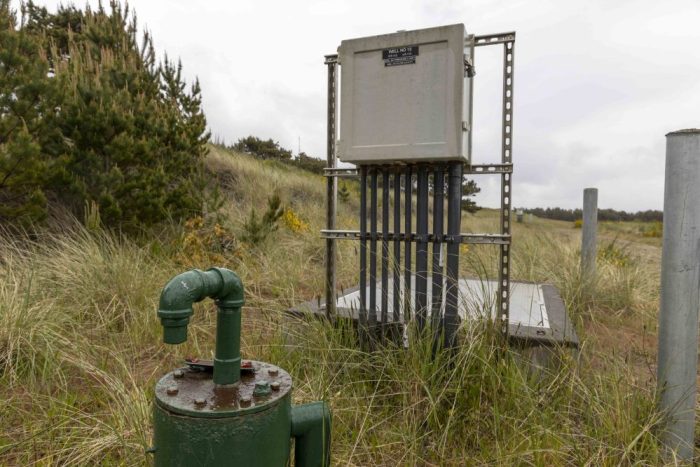Pulling the thread
Published 6:10 am Thursday, August 7, 2014

- A woman adds tassels to a street-sign pole wearing a sweater.
Most graffiti artists lurk in the shadows of night, clothed stealthily in black to tag buildings with caustic chemicals that burst from aerosol cans.
Not Astoria’s recent graffiti gang.
A herd of mostly women took to the streets in broad daylight twirling knitting needles instead of spray cans, tagging stop signs, benches, door handles, flower pots, trees and statues with fuzzy yarn in attempts to make Astoria a little bit prettier.
Yarn bombing is an artistic movement just shy of a decade old. It combines three disciplines – installation art, needlework and street art. Yarn bombs are less permanent than traditional graffiti and the colorful displays of knitted and crocheted yarn can easily be removed if necessary unlike spray paint and chalk.
The movement got its start with a doorknob and some blue and pink acrylic yarn.
In 2005, a self-taught knitter, Magda Sayeg of Houston, knitted a blue and pink cozy to cover her boutique’s front-door doorknob. After noticing the smiles of passers-by, she decided to cover more of the city – street signs, flower pots and more doorknobs.
This piece is now considered the alpha piece in the yarn-bombing movement.
It snowballed from there.
Soon after Sayeg, who is also known as PolyCotN, co-founded a group with an anonymous friend named AKrylik. The group of 12 knitters called themselves ‘Knitta Please,’ a play on crafting terminology and hip-hop. Several of the other group members were Knotorious N.I.T, SonOfaStitch and P-Knitty.
Knitters joined the group as a way to cope with the frustration of unfinished knitting projects and as a creative way to use knitting scraps.
The idea was for knitters and crocheters to use their imaginations to make ordinary objects more beautiful – utility poles, fences, doorsteps, VW buses, parking meters, telephone booths, etc. The group’s signature bomb was the car antenna cozy. A quick and easy colorful surprise for car owners.
Knitta Please collectively tagged a section of the Great Wall of China, spots in France, Germany, Sweden, El Salvador and Canada, taxi cabs in New York and even sections on the Golden Gate Bridge in San Francisco.
Although Knitta Please eventually shrunk to Sayeg as the only remaining member, the idea of yarn bombing became an international guerrilla knitting movement – artists of all ages everywhere embraced the idea. Scandinavia, Japan and South Africa are just a few of the countries who have seen fuzzy bombs.
Local yarn-bombers and curious visitors covered the streets of Astoria this past June with fuzzy bombs.
In January, the Astoria Fiber Arts Academy was selected to receive a $1,000 grant to go toward promoting tourism, art and culture. The academy decided to do a 24-hour yarn bombing.
Margaret Thierry of the Astoria Fiber Arts Academy headed the gang of yarn-bombers.
A group of between 20 and 30 bombardiers set out on foot to sprinkle the town with color. They began bombing at noon on Friday the 13th with a goal of finishing noon Saturday. Their plan of attack was to focus on tagging the area between 14th and 16th streets on Marine Drive, the little park in the area and the anchor outside the Columbia River Maritime Museum.
Prior to the bombing, Thierry ran the group’s plan past Brett Estes, Astoria’s city manager pro tem, to ensure everything they planned to do was OK.
“They told us if we were going to bomb any storefronts or private property, we would have had to ask for permission,” Thierry said. “But we didn’t do any of that.”
The stop signs on Marine Drive and Commercial Street were off-limits because they are along the highway and considered Oregon Department of Transportation signs, and therefore not the city’s property.
“I wanted to do put a hat on the Indian, but we didn’t get to that this year,” Thierry laughed, referring to the Chief Comcomly wooden sculpture near the roundabout on the west end of town. “You know – the penis head that some local guys put a condom on one year for Halloween. We are hoping to get to that next year.”
The yarn-bombers included people involved with the Fiber Arts Academy and Clatsop Weaver’s & Spinner’s Guild, local artists, some visiting artists and curious passers-by.
Thierry sent out postcards and cover letters to all the knit shops in Oregon and Washington explaining the yarn bombing and nagging people to partake.
“I didn’t know how many people would respond,” Thierry said. “I did get some response, but I figured out postcards are not the best way to do it. This was our first year though, so live and learn.”
One mixed media artist, Bonnie Meltzer from Portland, contributed a great deal to the bombing’s success. She was responsible for the tall, crocheted yarn woman hanging outside the academy. The figure was named Arachne after the Greek myth in which a mortal woman and talented weaver challenges Athena, goddess of wisdom and crafts. Athena later turned Arachne into a spider so she can weave for eternity.
“On the day of the yarn Bomb, we had an impromptu crochet workshop,” Melzer said. “Some learned to crochet for the first time, and made embellishments for “Arachne.” She is crocheted with yarn and wire. Some people came because they responded to press coverage, but others were just walking down the street and were captivated. One such person thought she would stay for 15 minutes, but crocheted all afternoon.”
Although the rest of the yarn bombings have been snipped down, Arachne still exists and will until she becomes icky from the ocean air.
‘They told us if we were going to bomb any storefronts or private property, we would have had to ask for permission.’
— Margaret Thierry
organizer





